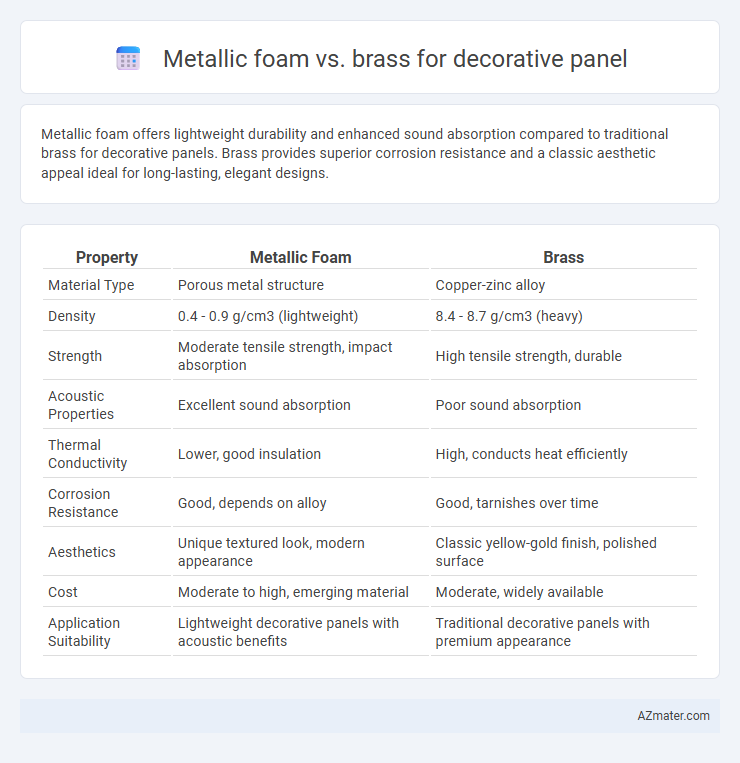Metallic foam offers lightweight durability and enhanced sound absorption compared to traditional brass for decorative panels. Brass provides superior corrosion resistance and a classic aesthetic appeal ideal for long-lasting, elegant designs.
Table of Comparison
| Property | Metallic Foam | Brass |
|---|---|---|
| Material Type | Porous metal structure | Copper-zinc alloy |
| Density | 0.4 - 0.9 g/cm3 (lightweight) | 8.4 - 8.7 g/cm3 (heavy) |
| Strength | Moderate tensile strength, impact absorption | High tensile strength, durable |
| Acoustic Properties | Excellent sound absorption | Poor sound absorption |
| Thermal Conductivity | Lower, good insulation | High, conducts heat efficiently |
| Corrosion Resistance | Good, depends on alloy | Good, tarnishes over time |
| Aesthetics | Unique textured look, modern appearance | Classic yellow-gold finish, polished surface |
| Cost | Moderate to high, emerging material | Moderate, widely available |
| Application Suitability | Lightweight decorative panels with acoustic benefits | Traditional decorative panels with premium appearance |
Introduction to Decorative Panel Materials
Metallic foam offers a lightweight, porous structure that provides unique aesthetic textures and excellent acoustic properties for decorative panels. Brass panels deliver a classic, durable finish with superior corrosion resistance and a warm metallic luster suitable for elegant interior designs. Both materials enhance visual appeal, with metallic foam emphasizing modern, innovative designs and brass highlighting traditional luxury in decorative applications.
What is Metallic Foam?
Metallic foam is a lightweight, porous material made by introducing gas bubbles into molten metal, resulting in a structure with high strength-to-weight ratio and excellent acoustic absorption. Unlike brass, which is a dense and corrosion-resistant alloy primarily composed of copper and zinc, metallic foam offers enhanced thermal insulation and unique aesthetic textures ideal for modern decorative panels. Its open-cell or closed-cell configuration allows for creative design flexibility, making it a versatile choice for architectural applications seeking both functionality and striking appearance.
Understanding Brass as a Decorative Material
Brass, an alloy of copper and zinc, is prized for its warm golden hue and excellent malleability, making it ideal for intricate decorative panel designs. Its natural corrosion resistance and ability to develop a patina over time enhance aesthetic appeal and durability in architectural applications. Compared to metallic foam, brass offers a solid, dense surface with superior structural integrity and timeless elegance for ornamental panels.
Aesthetic Differences: Texture and Appearance
Metallic foam offers a unique, porous texture with a matte or satin finish that creates an industrial and modern aesthetic, enhancing light diffusion and depth. Brass provides a smooth, polished surface with warm golden hues and reflective qualities, giving a classic, luxurious appearance that evolves with patina over time. The choice between metallic foam and brass for decorative panels impacts the visual appeal, with metallic foam emphasizing rugged, organic patterns and brass delivering bright, elegant refinement.
Weight and Structural Considerations
Metallic foam offers a significant weight advantage over brass, reducing the overall mass of decorative panels by up to 70%, which facilitates easier installation and lowers structural load requirements. Brass, being denser and heavier with a density around 8.5 g/cm3 compared to metallic foam's approximate 0.5 to 1.0 g/cm3, demands more robust framing to support its weight. Structural considerations favor metallic foam when lightweight strength and impact absorption are prioritized, whereas brass provides superior rigidity and traditional aesthetic appeal but at the cost of increased weight and potential need for reinforcement.
Durability and Longevity Comparison
Metallic foam offers enhanced durability due to its high strength-to-weight ratio and excellent impact resistance, making it less prone to dents and deformation compared to brass. Brass, while corrosion-resistant and aesthetically appealing, may tarnish over time and require regular maintenance to preserve its appearance. In terms of longevity, metallic foam panels typically retain structural integrity longer under harsh environmental conditions, whereas brass panels are favored for classic, timeless finishes but might need refurbishment to maintain their decorative appeal.
Cost Implications of Metallic Foam vs Brass
Metallic foam offers a cost-effective alternative to brass for decorative panels due to its lower material and manufacturing expenses, as it requires less raw metal and energy-intensive processing. Brass panels tend to incur higher costs because of the alloy's price and complex fabrication processes like casting and machining that demand more time and labor. Choosing metallic foam can significantly reduce overall project budgets while maintaining aesthetic appeal and structural strength in decorative applications.
Customization and Design Flexibility
Metallic foam offers superior customization and design flexibility compared to brass due to its lightweight structure and porous texture, allowing intricate patterns and unique shapes that enhance aesthetic appeal. Brass provides classic elegance but is limited by its solid form and higher weight, restricting complex modifications and intricate detailing. Designers favor metallic foam for innovative, customizable decorative panels that combine strength with artistic freedom.
Environmental Impact and Sustainability
Metallic foam offers superior environmental benefits compared to brass for decorative panels due to its lightweight nature, which reduces material usage and lowers transportation emissions. The high recyclability of aluminum-based metallic foam enhances sustainability by enabling repeated reuse without significant loss of properties. Brass, while durable and recyclable, typically requires more intensive mining and energy consumption during production, resulting in a larger carbon footprint.
Best Applications: Choosing the Right Material
Metallic foam offers lightweight, high-strength properties ideal for decorative panels requiring sound absorption and thermal insulation, making it perfect for modern architectural designs and acoustic treatments. Brass provides a classic, corrosion-resistant finish with excellent malleability, suited for ornamental panels in luxury interiors and heritage restorations where visual appeal and durability are paramount. Selecting the right material depends on whether functional performance like weight and insulation or aesthetic qualities like color and craftsmanship are the priority.

Infographic: Metallic foam vs Brass for Decorative panel
 azmater.com
azmater.com